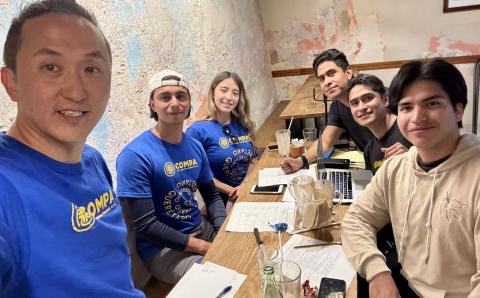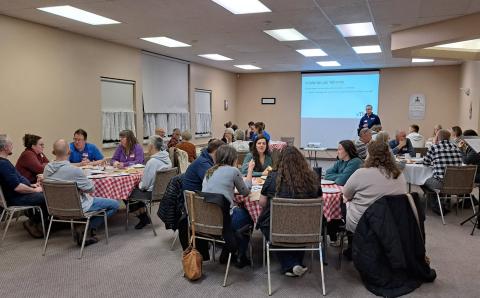About 40 years ago my dad’s oldest sibling, Aunt Clara, showed me a picture I had never seen before. It was the lone surviving photo of my long-deceased great-grandpa Einfeld, taken sometime around 1900 in the Netherlands. Aunt Clara seemed eager to reveal a closely held family secret. My great-grandpa, she said, had been a “German Jewish seaman.” Jewish?! I was flabbergasted. How could that be true? My dad was a Christian Reformed minister. His Dutch immigrant parents were devout lifelong members of the Christian Reformed Church. But my aunt sure sounded convincing.
When online genealogical databases later emerged, I began checking out her story. I discovered that my great-grandpa had been born in the North Sea coastal town of Norden, Germany, and was baptized as an infant in a Lutheran church. In fact, he was the sixth consecutive generation of Einfeld sons who had all been baptized as German Lutherans. However, the three earliest generations of those sons, who lived during the 17th and 18th centuries, all shared a hereditary name that revealed something more. That name was Juede—the German word for Jew. It was the handy ID tag often used back then to underscore the alien minority social status of those from Jewish ethnic descent. Aunt Clara had been right about my great-grandfather’s ethnic origins!
The implications jolted my sense of identity. My lifelong Christian identity meant patriarchal Abraham had been my spiritual father. But now I realized l also had a genetic connection to him. I had inherited his DNA. Suddenly the entire biblical account seemed even more personal. All those familiar Bible stories I had grown up hearing and reading? My own flesh-and-blood ancestors had experienced them firsthand. Egyptian bondage. Mount Sinai. The desert wanderings. Crossing the Jordan. Babylonian conquest. Herod’s psychopathic tyranny. The ministry, death, and resurrection of Jesus. And speaking of Jesus, perhaps my own ancestors had seen and heard him in person. If so, how had they responded? What stories might they have been able to tell?
Additional questions begged for answers. How did it happen that a descendant of those first-century Palestinian Jewish contemporaries of Jesus turned up in the far-flung North Sea coastal region of 17th-century Germany as my earliest documentable paternal ancestor? The more I unearthed about the contours of these ancestors’ long migratory journey—from Palestine to Italy, from Italy across the Alps into and across German territory—the more astounded I was that I had even come to exist.
How, for example, had they survived the violent bloodshed that wiped out more than 200,000 of their fellow Palestinian Jews during the period from Herod the Great to Rome’s annihilating conquest in A.D. 70? How had they survived the 1096 massacre of 12,000 Rhineland-area Jews—about half of the Jewish population there? A ragtag crusading mob of French and German peasants, seething with anti-Muslim venom, had sewn crosses on their clothes and set off to rescue the Holy Land from its desecrating Islamic occupiers. While passing through Rhineland Jewish communities along the way, however, their righteous anger was momentarily diverted. Here, they thought, were the very people whose guilt for murdering Jesus had been left unpunished. Surely they were as deserving of God’s justice as were the Holy Land’s Muslim invaders. The Jewish people were thus given a choice: be baptized or die.
And how had my ancestors avoided the systematic execution of more than half of the German Jewish population via the horrendous “Jewish bonfires” of the mid-1300s? The dreadful Black Death pandemic had spawned wild-eyed conspiracy theories, and one outrageous false rumor that spread like wildfire suggested the Jews had poisoned Europe’s water supplies in an attempt to kill off the Christians. Vengeful, lawless, terrorizing “Christian” mobs consequently took matters into their own hands.
QAnon-like anti-Jewish conspiracy theories ran rampant within medieval Germany’s gentile population. They imagined that the blood spilled during Passover by their Jewish neighbors must really be that of Christian children, that the Jews were bent on extinguishing Christianity, that Jews hated Jesus so much they were still trying to murder him by stealing consecrated Catholic church communion wafers, believed to be the literally transformed physical body of Jesus, cursing them, and stabbing them until they bled.
Such a conspiracy theory led to the execution of 38 Jews in the eastern German territory known as the Mark Brandenburg in 1510. Following trumped-up charges of stealing and mutilating communion wafers and then torture-induced “confessions,” they appeared in a Berlin court wearing humiliating pointed yellow hats to hear the verdict: guilty of heresy and sorcery. Their sentence: death by fire. They were led in fetters through the streets of Berlin to a public square and fastened to a large scaffold, underlain with flammable kindling and tar, specially built for the occasion. The rabbi recited aloud the Jewish last will and testament. The condemned repeated the prayer and recited psalms to the very end as they were burned alive. (Their innocence, incidentally, was proven in 1539 with the help of Martin Luther’s cohort, Phillip Melanchthon.)
Anti-Jewish sentiment among Brandenburg-area residents now reached a fever pitch. The prince had no choice but to expel the few hundred Jewish men, women, and children residing in his territory. Escorted to the border and banished from the realm, they dispersed in various unknown directions. A handful, however, appear to have found their way to the far northern German territory of Ostfriesland seeking safe harbor. Evidence suggests a strong likelihood that my earliest Ostfriesland Jewish ancestor had been among these beleaguered immigrant refugees.
I try to visualize the 150 or so generations of my paternal ancestors who have come and gone since the days of Abraham. I see them stretched out across the centuries, spanning all the places they temporarily called home during their long migratory journey: Palestine, Italy, Germany, the Netherlands, Canada, the U.S. And as I take in this scene, I begin to notice something else. I see the hand of Abraham’s sovereign God, Yahweh, the great I AM, emerging into full view. I am awe-struck.
The words of Psalm 100:5 come to mind: Yahweh’s “faithfulness continues through all generations.” That’s no mere trite-sounding theological concept. It’s an observable reality playing out in human history. Generations have come and generations have gone. But God’s faithfulness has outlasted them all. It cannot and will not be thwarted.
It continued unabated during the generations of Old Testament Israel despite all their faithlessness. It persisted during the time of Jesus and the first-century church, even when the Jewish community largely wrote Jesus off as an imposter messiah. It endured during the first 15 centuries A.D. as my own Jewish ancestors clung to their long-held Jewish faith and hope in Yahweh. It was evident in the 17th century when they were enfolded into the German Lutheran church community. It’s been corroborated by my own family’s 400-year-long, generation-to-generation Christian heritage and by the Christian professions of my own children and grandchildren.
But what about the future? Western Christianity appears to be in rapid decline. We’ve watched as 40 million American Christians have dropped out of church during the past 25 years. We’ve seen church infrastructures unraveling, budgets shrinking, ministries closing, pastors quitting. Christianity’s influence seems stifled, its voice drowned out, its witness poisoned by a clamoring, fear-driven, angry Christian nationalist spirit that disfigures the true image of Christ. If there were ever a time when we need reminding that God is faithful to his redemptive purposes, and that his faithfulness will endure unimpeded through all future generations, that time is now.
About the Author
Doug Einfeld is a retired Christian Reformed pastor and a current member of Covenant Life CRC in Grand Haven, Mich. He is writing a book retracing the story of his Jewish ancestors from biblical times to their 17th-century arrival in northern Germany. His website is dougeinfeld.com.









